How to cage-trap, vaccinate and mark badgers to control bovine TB
Updated 28 March 2024
Applies to England
This guidance is for people trained and licensed to cage-trap, vaccinate and mark badgers in England to carry out this work safely, humanely and efficiently.
Find out how to:
- get trained to set cage traps, vaccinate and mark badgers
- register for licences to cage-trap and mark badgers (CL48 and CL49)
When to cage-trap badgers
You can only trap badgers in England between 1 May and 30 November. This is to reduce the risk of:
- leaving dependant cubs underground
- exposing trapped badgers to severe weather
You must not set traps to catch in extreme weather conditions, for example in:
- strong wind
- heavy or prolonged rain
- very low or high temperatures
Read Licence CL48 condition 1: protecting animal welfare.
You should plan to vaccinate at the same sett or trapping location for at least 4 consecutive open seasons. This is so you can vaccinate any badger cubs or adults that join the social group during that time.
Getting access to land
Before you start placing traps, you should get a:
- written agreement from the landowner to say that you can access their land
- map that shows the areas you’ve been given access to
Read Licence CL48 condition 3: accessing land.
Finding badger field signs and identifying active setts
Once you have permission from the landowner to access the land, you can begin your survey for badger field signs and their setts.
Complete a survey of the land so you know:
- the level of badger activity in the area
- where to set cage traps to catch
To help you identify if there are badgers in the area or a sett is active, look for these signs:
- sett entrances with large heaps of freshly dug soil
- clear, worn runs or sett entrances
- bedding in front of sett entrances
- badger latrines
- badger hair caught on fencing
- paw prints
Creating bait points
Once you are ready to begin trapping, check the badger setts and other areas identified in your survey to see if they are still active. You should then create a series of bait points near areas of badger activity to:
- introduce badgers to bait
- confirm presence and levels of activity of badgers
- find out where to place traps
This method should reduce the chance of rodents and other non-target species from taking the bait.
-
Dig a hole about 10cm deep (a spade’s depth).
-
Fill it with a handful or 2 of peanuts.
-
Cover the hole firmly with earth and heal in.
-
Put a large flat natural stone on top, heavy enough that only badgers can move it (at least 3kg).
Check and replace eaten bait every 1 to 2 days.
Once the badgers are regularly using the bait points, usually after 2 to 3 days, you should dig in traps at those locations.
What bait to use
Animal grade peanuts are the preferred bait for trapping badgers. Other types of bait you may use include:
- animal-grade peanuts
- wheat
- maize
- rolled oats
Badgers are most active at night. You should place bait points or pre-bait traps late in the afternoon, before sunset, to avoid:
- other animals eating the bait during the day
- disturbing badgers when they’re active
If badgers do not take the bait, you can try adding golden syrup, peanut butter or fruit. You must not use animal-based feed, for example, dog food.
You should wear disposable gloves when handling bait, stones or equipment that badgers may come into contact with.
Placing traps
Use your survey of the area and your bait points to decide:
- where to set cage traps to catch
- how many traps you need
To capture badgers humanely, you must only use cage traps that are certified and suitable for use in England. Read Licence CL48 Condition 11: cage trap specifications.
You should place your traps during daylight hours when badgers are inactive, so you do not disturb any and risk driving them away.
You should check your traps are in good working condition each time you use them and replace or repair any faulty or damaged parts.
Where to place traps
Place traps on and around active badger setts, but not blocking entrance holes and runs.
To protect badgers from extreme weather, you must place traps in areas with natural cover. This could include large trees and bushes or walls, fences and hedgerows.
Avoid areas where:
- livestock or domestic animals could disturb, get injured by or caught in the trap
- the traps can be easily found by the public
- there is a risk of flooding
Do not place traps along fence lines where a low strand of barbed wire could cause injury to a trapped badger if it reaches out through the mesh.
Remote trapping
You can also place traps at well-used latrines or runs away from setts, known as ‘remote trapping’, to target badgers entering from surrounding land.
You should take care if you’re remote trapping in the early part of the season – between May and July – when young cubs may get caught without their parents. If a remote trap catches any young cubs, vaccinate and mark them before carrying the trap to the closest sett entrance and releasing them.
Securing traps
Dig traps into the ground and cover the mesh base with 2cm to 3cm of soil. If the trap is on a slope, the trap must be in a stable position to avoid toppling over. Use wooden stakes to make traps stable, if necessary. Make sure the door can open and close fully.
Read Licence CL48 condition 4: placing traps.
Baiting traps
Before you put down bait, you should lock your traps open once they’re in place, using 2mm plastic-coated wire or cable ties.
You should pre-bait for 7 to 10 days to encourage badgers to get used to taking the bait. This will increase the chance of successfully trapping them.
Start with a bait point outside the trap entrance. Once the badgers take the bait, move the bait inside the trap and cover it with a large flat stone. When the badgers have taken the bait inside the trap, move the bait towards the back of the trap over several days. To place bait at the back of the trap, use a spade or insert a plastic tube through the top of the trap.
If other species are taking the bait, you could put it in a dish (for example, a terracotta saucer or clay-pigeon target) and cover it with a large flat stone. Dishes should be large enough to hold 1 to 2 handfuls of peanuts.
Aim to place the bait in a ‘neat’ pile inside the trap. You could use a long tube to avoid spilling bait around the trap because this may attract other species and encourage badgers to dig under the trap. If this happens, you can stack branches or large stones around the trap to prevent animals digging around the back and sides of traps.
If badgers do not take the bait after 2 to 3 days, replace the peanuts with fresh ones. Remove mouldy bait.
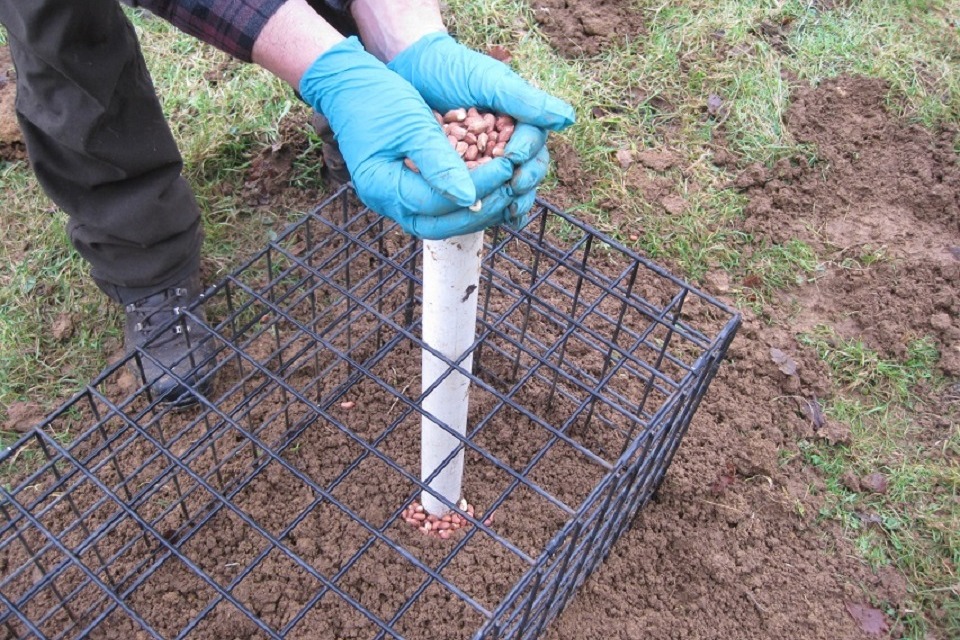
You can use a tube to place the bait in a neat pile
Setting traps to catch
Once badgers are regularly entering the traps to take the bait, you should set the traps to catch them.
You should set traps before sunset, to avoid disturbing badgers at night.
Set your traps for 2 consecutive nights. If you do not catch any badgers, you can extend this but for no more than 4 consecutive nights to avoid disturbing resident badgers.
If you catch any marked badgers, stop cage-trapping at this location. This will prevent badgers from being trapped for more than 2 nights. See the ‘marking badgers’ section.
Record the number of traps set to catch at each trapping location on TRAPP (the reporting app) or a notebook and trap location map. You must record the locations clearly enough that all the traps could be found by someone else, if the original operator is unavailable.
Do not set more traps than you are able to check within the times set out in the licence. Read Licence CL48 condition 6: checking cage traps.
Stringing up
‘Stringing up’ is how you set the trap to catch.
When you’re stringing up, it may help to hold the trap door open by inserting the trigger arm on the door into the trigger plate on top of the trap.
You should use one of these 2 methods.
Twine, wire and stone method
This is the preferred method.
1. Wrap a short length of wire around the large natural stone used to cover the bait – use 2mm diameter plastic-coated garden wire.
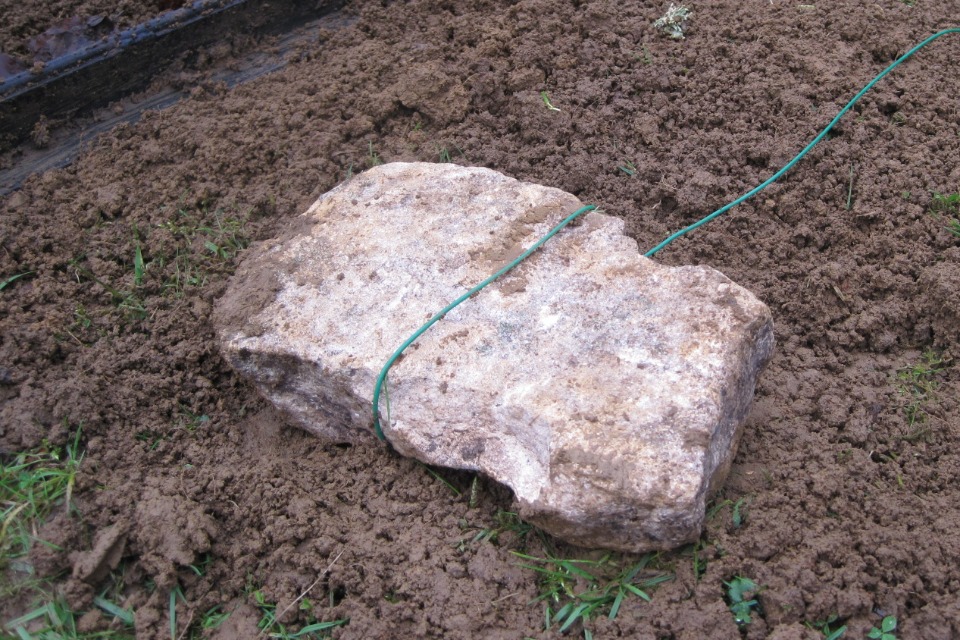
2. Place a double handful of peanuts at the back of the cage (in a dish if necessary).
3. Place the stone on top of the peanuts.
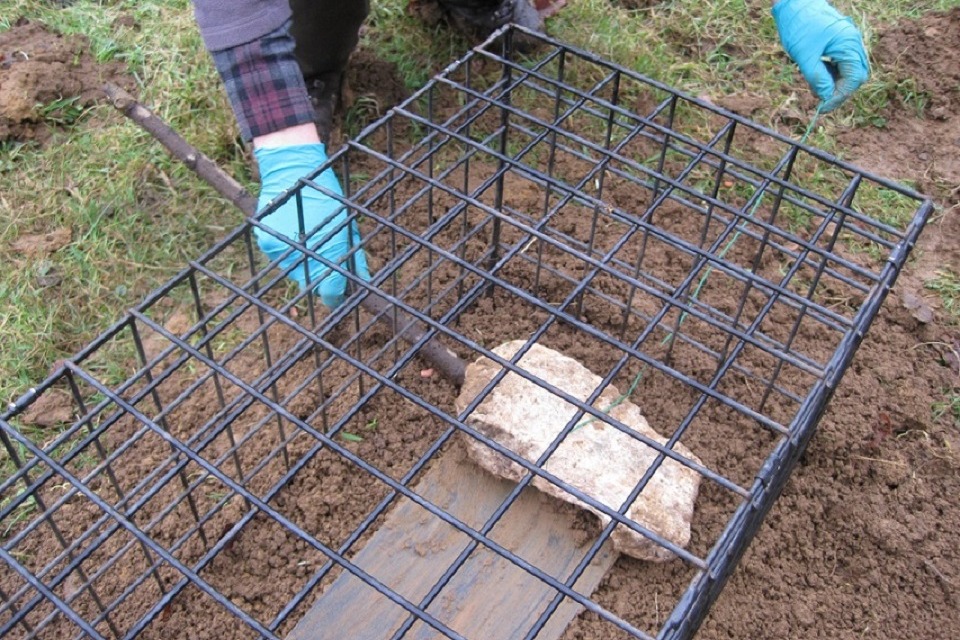
4. Extend the wire from the stone through the mesh at the back of the trap and approximately half to three-quarters of the way up.
5. Create a loop at the top of the wire.

6. Attach 2 to 3 ply twine to the loop and extend the twine up the rear of the trap and through the roof of the cage at a 45° angle.
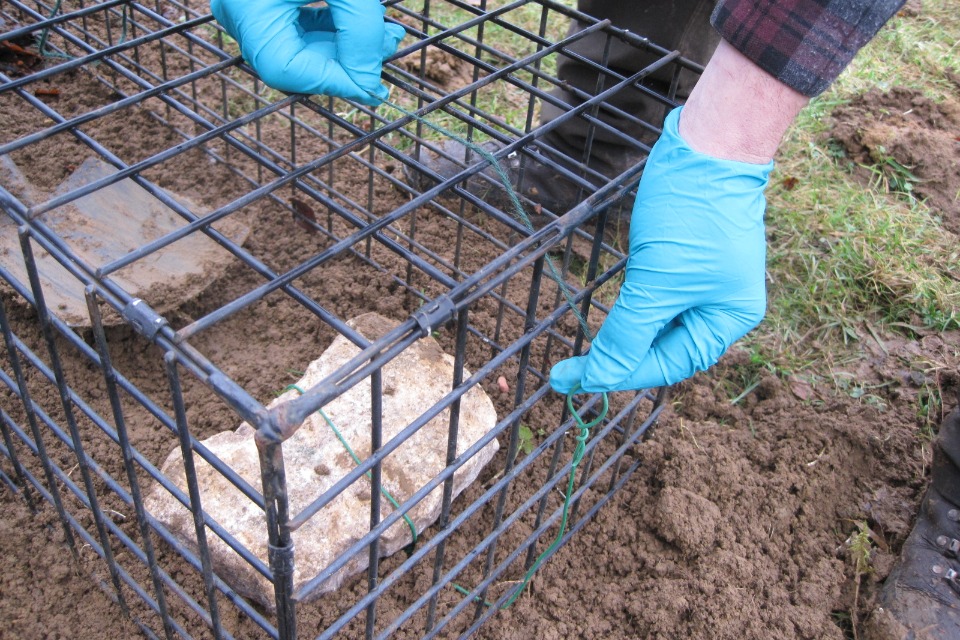
7. Tie the twine to the top hole of the trigger plate. Do not tie the twine too tightly, to allow for shrinkage in wet weather or anything falling or landing on it.
8. Position the trigger plate vertically, at right angles to the top of the trap.

9. Place the end of the trigger arm in the lowest hole of the trigger plate, so that you can easily pull it free when the baiting stone is moved and the door will close.
10. Test the door-closing mechanism to make sure it closes properly.
11. Set the trap to catch.
If a badger flips the stone up instead of pulling it towards the front of the cage to uncover the bait, the trigger mechanism will not work. If this happens, you should use the twine triangle method.
Twine triangle method
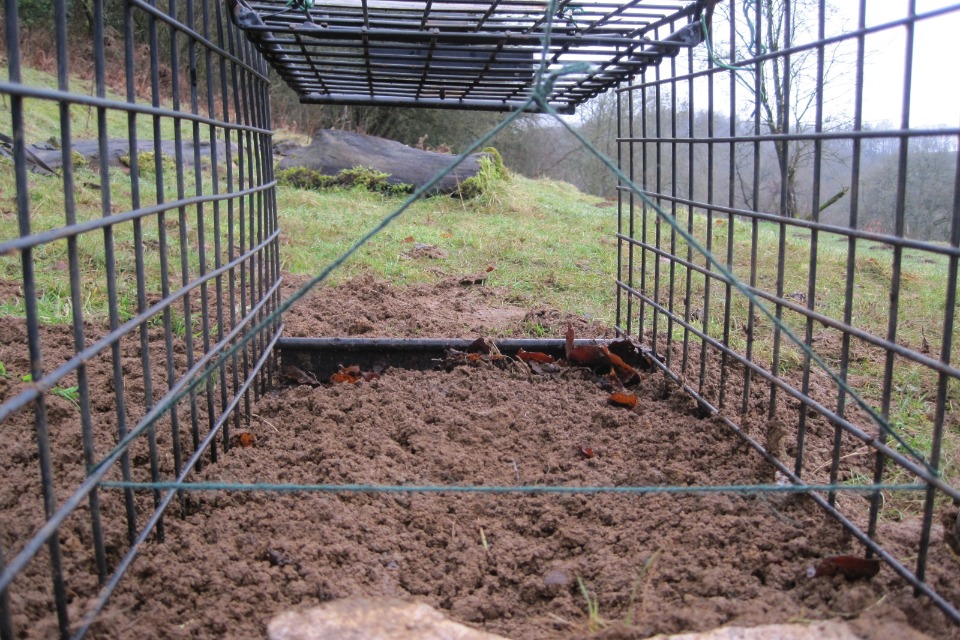
-
Place bait at the back of the trap and cover with a stone.
-
Make a twine triangle trip-line inside the trap (approximately 6 squares from the rear of trap and 2 squares from the floor) just in front of the stone.
-
Extend the end of the twine out through the roof and along the top of the trap to the top hole of the trigger plate and tie it to the top hole of the trigger plate.
-
Test the door-closing mechanism to make sure it closes properly.
-
Set the trap to catch.
The problem with this method is that other species such as pheasants and squirrels are more likely to trip the trap than badgers.
Checking traps for badgers
Traps should be checked for badgers by either:
- the person who set them
- someone who watched them being set
You need to check any cage traps you’ve set to catch by the times set out in your licence:
- May to August – up to 9:30am
- September – up to 10:30am
- October to November – up to 11:30am
You should prioritise checking traps that are most at risk of exposure to extreme weather conditions, or of being disturbed by the public or livestock.
Approach traps slowly and quietly to avoid causing unnecessary stress to any animals inside the trap.
Handling vaccine
You’ll need a prescription from your prescribing vet for BadgerBCG, which is a live vaccine .
Storing the vaccine
You must:
- refrigerate and store the vaccine and diluent at 2° to 8°C before reconstituting
- keep accurate temperature records
- store the vaccine in its original packaging to protect it from the light
You must use it before the expiry date.
If the vaccine is stored in a fridge close to the vaccination area, it may be possible to reconstitute the vaccine before travelling to the site. If this is not possible, use a portable fridge or vaccine carrier to store the vaccine until it is ready to be reconstituted and used in the field.
Preparing the vaccine
The BadgerBCG is supplied in 2 parts:
- vaccine
- diluent
You need to mix these together (‘reconstitute’) and use the reconstituted vaccine within 4 hours.
To avoid waste, you need to know the number of trapped, unvaccinated badgers before preparing the vaccine.
You must wear protective nitrile gloves to mix the vaccine.
Only use the diluent provided with BadgerBCG for reconstitution.
To reconstitute the vaccine with the diluent, use a syringe fitted with a needle.
-
Uncap the needle.
-
Draw up the liquid in the diluent vial, then transfer to the vaccine vial.
-
Carefully invert the vial a few times to re-suspend the vaccine but do not shake.
-
Draw up 1ml of the vaccine suspension.
-
Carefully discard the uncapped needle in the purple-lidded sharps bin and fit a capped needle onto the syringe.
-
Place the loaded syringe in a small container (for example, a Peli case) to take it to the trap.
The reconstituted vaccine should look slightly opaque (cloudy) and colourless. If it does not look right, do not use the vaccine and inform the prescribing vet.
Reconstitute vaccine away from the cage traps to avoid distressing the badgers.
Disposing of the vaccine
Throw away any empty BadgerBCG vials and used needles and syringes in an appropriate purple-lidded sharps bin. This includes any that are:
- broken
- discoloured
- used or part-used
- stored at the wrong temperature
- out-of-date
- reconstituted but not used within the 4-hour window
- less than 1ml after reconstitution
Checking badgers before vaccinating
Check the badger has not already been vaccinated during the current season. This will be indicated by a large fur clip and stock marker on the middle of the back of the animal.
You must observe the badger in the trap before vaccinating. The vaccinator must carry out a thorough welfare assessment of the badger to decide if:
- it’s fit to vaccinate
- it’s fit for release
- you need to consult or call out a vet
Thoroughly check the badger for these 5 criteria:
- demeanour – general behaviour and how responsive it is
- respiration – how it’s breathing
- body condition – how healthy their fur and weight are
- injuries
- movement – can it stand and move freely, using all 4 legs
You must record the results of this assessment for each trapped badger on TRAPP (the reporting app) or the VF3 form to comply with your licence.
You can vaccinate badgers that are observed as ‘normal’ or experiencing ‘common departures from normal’. You must consult a vet if the badger shows any abnormal signs.
Vaccinating badgers
During the welfare assessment and vaccination process, you should wear personal protective equipment (PPE) such as nitrile, powder-free gloves, FFP3 face masks and carry safety glasses to use if needed.
To administer the vaccine using a needle and syringe:
- uncap the needle
- inject into the thigh at an entry angle of 90° to make sure you inject only into muscle
- use stable pressure on the plunger
- remove the needle from the muscle
Once finished, dispose of the used syringe and needle in a purple-lidded sharps bin.
Many badgers can be vaccinated without restraint. If the badger is very active, you could keep it still by using a ‘wicket’. Never put covers or blankets over cage traps to try to calm the animals. They could get dragged into the traps and harm the badgers.
Checking badgers after vaccinating
Once the badger has been vaccinated, thoroughly observe it to check it has not:
- had an adverse reaction to the vaccine
- been injured in the process
Call a directing or attending vet if a badger:
- collapses
- has convulsions
- cannot move
- develops an immediate large swelling around neck or face
- shows any other signs of an adverse reaction to the vaccine
You must also report any adverse and suspected adverse reactions to the vaccine in form VF10 and either the TRAPP reporting app or form VF3 . You should also report reactions in humans after exposure to the BadgerBCG, for example, through accidental self-injection. Read the ‘Keeping records’ section in this guidance.
If a badger dies after being vaccinated
Get advice from your directing or attending vet if a badger has died from a suspected reaction to the vaccine. They should advise you on what to do with the carcass.
Marking badgers
You must mark a badger after it has been vaccinated.
1. Clip a patch of fur on the middle of the badger’s back, below the shoulder blades. Clip an area about the size of a playing card, 60mm by 90mm.
2. Use curved long-handled scissors to remove the outer dark guard hairs. This will expose their undercoat.

3. Spray the clipped area with a brightly coloured livestock marker, being careful to avoid the badger’s eyes or face.

Releasing badgers
You need to allow enough time to assess badgers’ welfare before releasing them.
Release the badger by opening the trap door. Make sure you’re not blocking the exit path.
The badger will usually leave the trap quickly. If they’re slow or unwilling to leave, step back or stand at the back of the trap to encourage the badger to exit the trap.
Where a trapped badger already has a fur clip and stock marker, release it after thoroughly checking it’s fit for release. Record this on the TRAPP app or VF3 form.
During the early part of the season – between May and July – if the trap catches a young cub, safely lift the trap and take it to the nearest active sett entrance to release it.
Once it’s empty, close or wire-open the cage-trap doors to avoid accidentally capturing badgers or other species during the day.
Releasing other trapped animals
You must release any captured non-target animals as soon as possible, at the place of capture, unless they cannot be legally released or they are injured.
See Condition 10: releasing non-target animals.
Keeping records
As part of your licence conditions, you need to record all badger trapping and vaccinating activity on TRAPP (the reporting app) or the VF3 form. You need to record this information for each trapping location on every morning that you check the traps.
You must also record these vaccination activities:
- BadgerBCG orders (VF5 form)
- BadgerBCG tracking (VF6 form)
- BadgerBCG disposal (VF7 form)
-
Storage refrigerator temperature record (VF8 form)
- Portable refrigerator or vaccine carrier temperature record (VF9 form)
- Pharmacovigilance (VF10 form)
You will receive these forms when you complete your training. You should keep your records, to show your prescribing vet if asked.
Cleaning and disinfecting equipment
You should regularly disinfect clothing and equipment using a disinfectant to reduce the chance of contamination between sites while vaccinating. For a list of TB-approved disinfectants read Defra-approved disinfectant: when and how to use it ..
Vehicles
Disinfect your vehicle wheels and other dirty areas:
- immediately after arriving at a new vaccination site
- before leaving a vaccination site
Equipment
You should disinfect your:
- boots when you arrive at a site and a soon as you leave, removing any mud or debris before applying disinfectant
- curved scissors and wickets on vaccination mornings using Clinell disinfectant spray and paper towels or wipes
If you need to move bait stones between different trapping sites, clean them with a pressure washer and disinfect them before reusing.
Traps
Before moving traps from a site, you should remove as much soil, vegetation or other debris as possible.
Do this at the site where the trap is located.
If the trap is on the edge of pasture, keep the debris away from cattle.
Take the traps to your depot to thoroughly clean and disinfect using an approved disinfectant before using them at another site. Or you could steam-clean them using a hot pressure washer (100°C).
Get help
For enquiries about cage-trapping and vaccinating badgers, email badger.vaccination@defra.gov.uk.
For enquiries about marking badgers after vaccination, email btbvaccination@naturalengland.org.uk.
